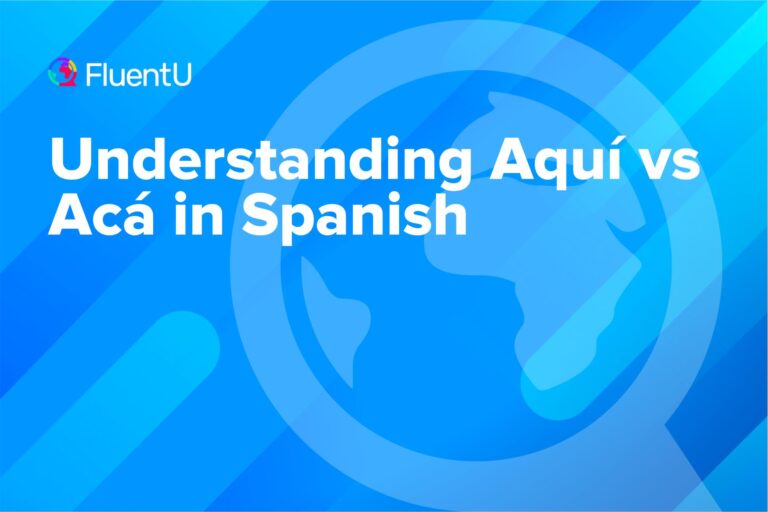Contents
- 1. Caber (To fit)
- 2. Caer (To fall)
- 3. Dar (To give)
- 4. Estar (To be)
- 5. Ver (To see)
- 6. Valer (To be worth)
- 7. Traer (To bring)
- 8. Salir (To leave)
- 9. Poner (To put)
- 10. Componer (To compose)
- 11. Disponer (To arrange)
- 12. Proponer (To propose)
- 13. Reponer (To replace)
- 14. Hacer (To do)
- 15. Deshacer (To undo)
- 16. Rehacer (To remake)
- 17. Saber (To know)
- 18. Conocer (To know)
- 19. Agradecer (To thank, to be grateful)
- 20. Aparecer (To appear)
- 21. Ofrecer (To offer)
- 22. Permanecer (To remain)
- 23. Pertenecer (To belong to)
- 24. Traducir (To translate)
- 25. Conducir (To drive)
- 26. Producir (To produce)
- 27. Tener (To have)
- 28. Andar (To walk)
- 29. Poder (To be able to)
- 30. Venir (To come)
- 31. Querer (To want)
- 32. Traducir (To translate)
- 33. Producir (To produce)
- Resources for Tackling Difficult Spanish Verbs
- And One More Thing…
33 Very Common Yet Hard-to-conjugate Spanish Verbs

There are many different types of verbs in Spanish, ranging from simple verbs with regular conjugations to intricate stem-changes.
We are going to look at 33 hard (but common) Spanish verbs, what makes them challenging and their conjugations.
Download: This blog post is available as a convenient and portable PDF that you can take anywhere. Click here to get a copy. (Download)
1. Caber (To fit)
Difficulty
- The first-person singular (the yo form) is irregular in the present tense.
- The stem changes to u in the preterit tense.
Irregular conjugations
Present tense: quepo, cabes, cabe, cabemos, cabéis, caben
Preterit tense: cupe, cupiste, cupo, cupimos, cupisteis, cupieron
2. Caer (To fall)
Difficulty
- The first-person singular (the yo form) is irregular in the present tense.
- The stem changes to i in the preterit tense.
Irregular conjugations
Present tense: caigo, caes, cae, caemos, caéis, caen
Preterit tense: caí, caíste, cayó, caímos, caísteis, cayeron
3. Dar (To give)
Difficulty
- The first-person singular (the yo form) is irregular in the present tense.
- The stem changes to i in the preterit tense.
Irregular conjugations
Present tense: doy, das, da, damos, dais, dan
Preterit tense: di, diste, dio, dimos, disteis, dieron
4. Estar (To be)
Difficulty
- The first-person singular (the yo form) is irregular in the present tense.
- The stem changes to uv in the preterit tense.
Irregular conjugations
Present tense: estoy, estás, está, estamos, estáis, están
Preterit tense: estuve, estuviste, estuvo, estuvimos, estuvisteis, estuvieron
5. Ver (To see)
Difficulty
- The first-person singular (the yo form) is irregular in the present tense.
Irregular conjugation
Present tense: veo, ves, ve, vemos, veis, ven
6. Valer (To be worth)
Difficulty
- The first-person singular (the yo form) is irregular in the present tense.
Irregular conjugation
Present tense: valgo, vales, valemos, valéis, valen
7. Traer (To bring)
Difficulty
- The first-person singular (the yo form) is irregular in the present tense.
- The stem changes to j in the preterit tense.
Irregular conjugations
Present tense: traigo, traes, trae, traemos, traéis, traen
Preterit tense: traje, trajiste, trajo, trajimos, trajisteis, trajeron
8. Salir (To leave)
Difficulty
- The first-person singular (the yo form) is irregular in the present tense.
Irregular conjugation
Present tense: salgo, sales, sale, salimos, salís, salen
9. Poner (To put)
Difficulty
- The first-person singular (the yo form) is irregular in the present tense.
- The stem changes to u in the preterit tense.
Irregular conjugations
Present tense: pongo, pones, pone, ponemos,ponéis, ponen
Preterit tense: puse, pusiste, puso, pusimos, pusisteis, pusieron
10. Componer (To compose)
Difficulty
- This verb is a compound form of poner. It follows the same pattern.
- Note that the compound forms of these verbs are also irregular in the yo form. Compound forms are pretty easy to spot because they show a prefix (des-, dis-, com-, con-, etc.) preceding the radical.
Irregular conjugations
Present tense: compongo, compones, compone, componemos componéis, componen
Preterit tense: compuse, compusiste, compuso, compusimos, compusisteis, compusieron
11. Disponer (To arrange)
Difficulty
- This verb is a compound form of poner. It follows the same pattern.
Irregular conjugations
Present tense: dispongo, dispones, dispone, disponemos, disponéis, disponen
Preterit tense: dispuse, dispusiste,dispuso, dispusimos, dispusisteis, dispusieron
12. Proponer (To propose)
Difficulty
- This verb is a compound form of poner. It follows the same pattern.
Irregular conjugations
Present tense: propongo, propones, propone, proponemos, proponéis, proponen
Preterit tense: propuse, propusiste,propuso, propusimos, propusisteis, propusieron
13. Reponer (To replace)
Difficulty
- This verb is a compound form of poner. It follows the same pattern.
Irregular conjugation
Present tense: repongo, repones, repone, reponemos, reponéis, reponen
Preterit tense: repuse, repusiste, repuso, repusimos, repusisteis, repusieron
14. Hacer (To do)
Difficulty
- The first-person singular (the yo form) is irregular in the present tense.
- The stem changes to i in the preterit tense.
Irregular conjugations
Present tense: hago, haces, hace, hacemos, hacéis, hacen
Preterit tense: hice, hiciste, hizo, hicimos, hicisteis, hicieron
15. Deshacer (To undo)
Difficulty
- This verb is a compound form of hacer. It follows the same pattern.
Irregular conjugations
Present tense: deshago, deshaces, deshace, deshacemos, deshacéis, deshacen
Preterit tense: deshice, deshiciste, deshizo, deshicimos, deshicisteis, deshicieron
16. Rehacer (To remake)
Difficulty
- This verb is a compound form of hacer. It follows the same pattern.
Irregular conjugations
Present tense: rehago, rehaces, rehace, rehacemos, rehacéis, rehacen
Preterit tense: rehice, rehiciste, rehizo, rehicimos, rehicisteis, rehicieron
17. Saber (To know)
Difficulty
- The first-person singular (the yo form) is irregular in the present tense.
- The stem changes to u in the preterit tense.
Irregular conjugations
Present tense: sé, sabes, sabe, sabemos, sabéis, saben
Preterit tense: supe, supiste, supo, supimos, supisteis, supieron
18. Conocer (To know)
Difficulty
- This verb changes from c to zc in the first-person singular only.
Irregular conjugation
Present tense: conozco, conoces, conoce, conocemos, conocéis, conocen
19. Agradecer (To thank, to be grateful)
Difficulty
- This verb changes from c to zc in the first-person singular only.
Irregular conjugation
Present tense: agradezco, agradeces, agradece, agradecemos, agradecéis, agradecen
20. Aparecer (To appear)
Difficulty
- This verb changes from c to zc in the first-person singular only.
Irregular conjugation
Present tense: aparezco, apareces, aparece, aparecemos, aparecéis, aparecen
21. Ofrecer (To offer)
Difficulty
- This verb changes from c to zc in the first-person singular only.
Irregular conjugation
Present tense: ofrezco, ofreces, ofrece, ofrecemos, ofrecéis, ofrecen
22. Permanecer (To remain)
Difficulty
- This verb changes from c to zc in the first-person singular only.
Irregular conjugation
Present tense: permanezco, permaneces, permanece, permanecemos, permanecéis, permanecen
23. Pertenecer (To belong to)
Difficulty
- This verb changes from c to zc in the first-person singular only.
Irregular conjugation
Present tense: pertenezco, perteneces, pertenece, pertenecemos, pertenecéis, pertenecen
24. Traducir (To translate)
Difficulty
- This verb changes from c to zc in the first-person singular only in the present tense.
- The stem changes to j in the preterit tense.
Irregular conjugations
Present tense: traduzco, traduces, traduce, traducimos, traducis, traducen
Preterit tense: traduje, tradujiste, tradujo, tradujimos, tradujisteis, tradujeron
25. Conducir (To drive)
Difficulty
- This verb changes from c to zc in the first-person singular only in the present tense.
- The stem changes to j in the preterit tense.
Irregular conjugations
Present tense: conduzco, conduces, conduce, conducimos, conducis, conducen
Preterit tense: conduje, condujiste, condujo, condujimos, condujisteis, condujeron
26. Producir (To produce)
Difficulty
- This verb changes from c to zc in the first-person singular only in the present tense.
- The stem changes to j in the preterit tense.
Irregular conjugations
Present tense: produzco, produces, produce, producimos, producís, producen
Preterit tense: produje, produjiste, produjo, produjimos, produjisteis, produjeron
27. Tener (To have)
Difficulty
- Irregular form in the present tense.
- The stem changes to uv in the preterit tense.
Irregular conjugations
Present tense: tengo, tienes, tiene, tenemos, tenéis, tienen
Preterit tense: tuve, tuviste, tuvo, tuvimos, tuvisteis, tuvieron
28. Andar (To walk)
Difficulty
- The stem changes to uv in the preterit tense.
Irregular conjugations
Preterit tense: anduve, anduviste, anduvo, anduvimos, anduvisteis, anduvieron
29. Poder (To be able to)
Difficulty
- The stem changes to ue in the present tense.
- The stem changes to u in the preterit tense.
Irregular conjugations
Present tense: puedo, puedes, puede, podemos, podéis, pueden
Preterit tense: pude, pudiste, pudo, pudimos, pudisteis, pudieron
30. Venir (To come)
Difficulty
- Irregular first-person singular form (the yo form) in the present tense, and stem change in other present tense forms.
- The stem changes to i in the preterit tense.
Irregular conjugations
Present tense: vengo, vienes, viene, venimos, venís, vienen
Preterit tense: vine, viniste, vino, vinimos, vinisteis, vinieron
31. Querer (To want)
Difficulty
- Irregular form with stem change in the present tense.
- The stem changes to i in the preterit tense.
Irregular conjugations
Present tense: quiero, quieres, quiere, queremos, queréis, quieren
Preterit tense: quise, quisiste, quiso, quisimos, quisisteis, quisieron
32. Traducir (To translate)
Difficulty
- This verb changes from c to zc in the first-person singular only in the present tense.
- The stem changes to j in the preterit tense.
Irregular conjugations
Present tense: traduzco, traduces, traduce, traducimos, traducis, traducen
Preterit tense: traduje, tradujiste, tradujo, tradujimos, tradujisteis tradujeron
33. Producir (To produce)
Difficulty
- This verb changes from c to zc in the first-person singular only in the present tense.
- The stem changes to j in the preterit tense.
Irregular conjugations
Present tense: produzco, produces, produce, producimos, producís, producen
Preterit tense: produje, produjiste, produjo, produjimos, produjisteis, produjeron
Resources for Tackling Difficult Spanish Verbs
“Practice Makes Perfect: Spanish Verb Tenses”
Author: Dorothy Richmond
This “Practice Makes Perfect” edition is ideally suited for beginner to intermediate level students and will help you finally understand how and when to use the appropriate tense and mood through everyday examples covering a wide variety of topics and about 250 engaging exercises.
“501 Spanish Verbs”
Author: Christopher Kendris
The principal behind this book is simple: Giving you an in-depth analysis of the 501 most commonly used verbs in Spanish and how to use them all in the 15 tenses and moods.
The seventh edition includes brand new content covering passive and active voice formation, an additional list of 2200 regular verbs to improve your learning, sentences demonstrating Spanish verb usage in all tenses, a CD-ROM which includes language learning aids and an audio CD that reviews the formation and usage of Spanish verb forms.
“A Frequency Dictionary of Spanish: Core Vocabulary for Learners”
Author: Mark Davies
This extremely complete and up-to-date Spanish frequency dictionary provides you with a list of the 5,000 most commonly used words in the language.
There’s a special section which provides a comprehensive list of the most used verbs (which is quite different from the list of the preceding book) along with their English equivalents and sample sentences.
“Spanish Verb Workbook”
Author: Frank R. Neussel, Ph.D.
This Spanish workbook will have you actually put into practice everything you’ll come to learn about la gramática española (Spanish grammar). Each chapter will present you with exercises covering fundamental conjugation information and illustrative dialogues for you to master every tense and mood over a period of time.
These are just a few resources to help you get a handle on Spanish verbs, and ideally, you should pair these books with other tools that can teach and also show you the verbs in action. That way, you can see all the rules that come into play when it comes to proper verb conjugation.
Immersion-based language learning programs are one such tool that can present Spanish verbs in context by using content that depicts real-life usage of Spanish. For example, FluentU uses short Spanish videos featuring native speakers.
FluentU takes authentic videos—like music videos, movie trailers, news and inspiring talks—and turns them into personalized language learning lessons.
You can try FluentU for free for 2 weeks. Check out the website or download the iOS app or Android app.
P.S. If you decide to sign up now, you can take advantage of our current sale!

By pairing book-based learning with constant exposure to realistic Spanish speech, you can more quickly master these finicky verbs. So put plenty of time and effort into practicing them, because it’ll be well worth it when you can craft some pretty impressive Spanish phrases.
So, there you have it! There was muchísima (a lot of) information in this post and you might want to bookmark this page so you can come back to it often and refresh your mind when you need to.
The more you use these difficult Spanish verbs, the easier it will become for you to use and understand them when spoken out loud or in your reading materials.
If you want to expand on this particular subject, feel free to refer to the recommended list of books included in the first section of this article. It’ll go a long way.
Good luck!
Download: This blog post is available as a convenient and portable PDF that you can take anywhere. Click here to get a copy. (Download)
And One More Thing…
If you've made it this far that means you probably enjoy learning Spanish with engaging material and will then love FluentU.
Other sites use scripted content. FluentU uses a natural approach that helps you ease into the Spanish language and culture over time. You’ll learn Spanish as it’s actually spoken by real people.
FluentU has a wide variety of videos, as you can see here:

FluentU brings native videos within reach with interactive transcripts. You can tap on any word to look it up instantly. Every definition has examples that have been written to help you understand how the word is used. If you see an interesting word you don’t know, you can add it to a vocab list.

Review a complete interactive transcript under the Dialogue tab, and find words and phrases listed under Vocab.

Learn all the vocabulary in any video with FluentU’s robust learning engine. Swipe left or right to see more examples of the word you’re on.

The best part is that FluentU keeps track of the vocabulary that you’re learning, and gives you extra practice with difficult words. It'll even remind you when it’s time to review what you’ve learned. Every learner has a truly personalized experience, even if they’re learning with the same video.
Start using the FluentU website on your computer or tablet or, better yet, download the FluentU app from the iTunes or Google Play store. Click here to take advantage of our current sale! (Expires at the end of this month.)







